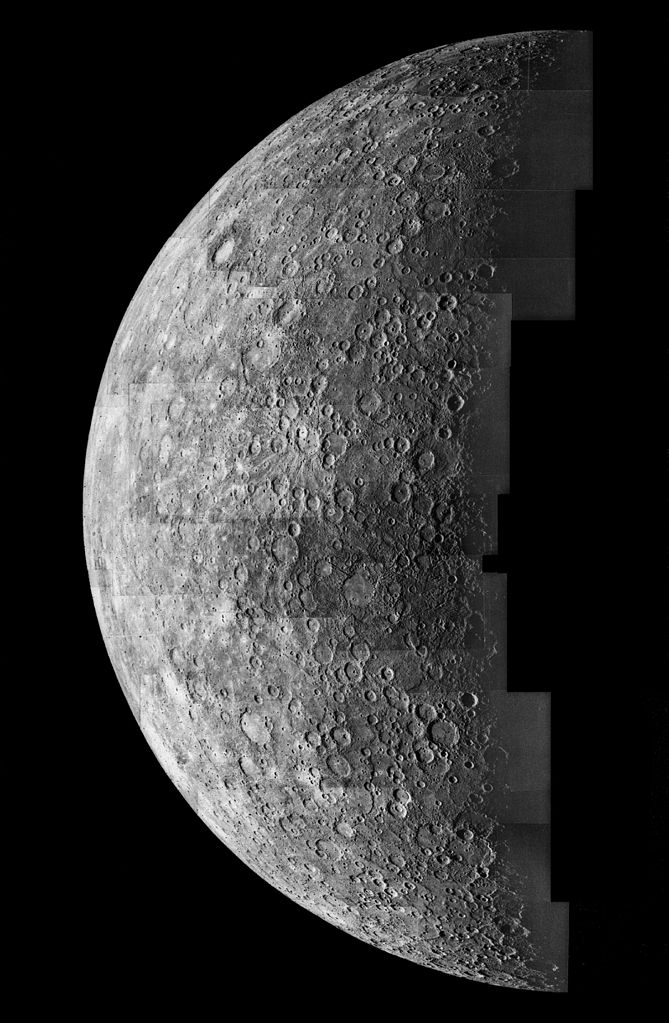
Image courtesy of NASA/JPL
 Copyright © Michael Richmond.
This work is licensed under a Creative Commons License.
Copyright © Michael Richmond.
This work is licensed under a Creative Commons License.
We can't see Mercury clearly using ground-based telescopes, partly because it's so small and so far away, and partly because it is always close to the Sun. Our first good view of the planet came in 1975, when Mariner 10 flew past.

Image courtesy of
NASA/JPL
Q: What is your first impression of Mercury?
Craters. Craters. Craters.
Between 2008 and 2015, the Messenger spacecraft orbited the planet many times and acquired a wealth of data.
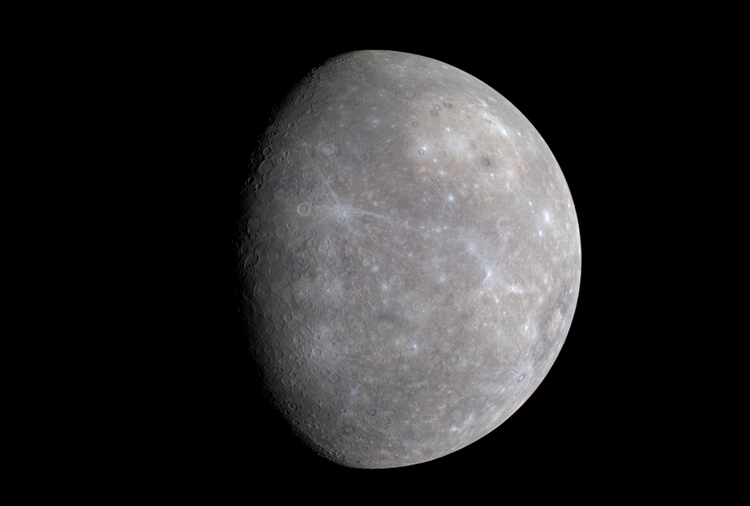
Image of Mercury courtesy of
NASA/Johns Hopkins University Applied Physics Laboratory/Carnegie
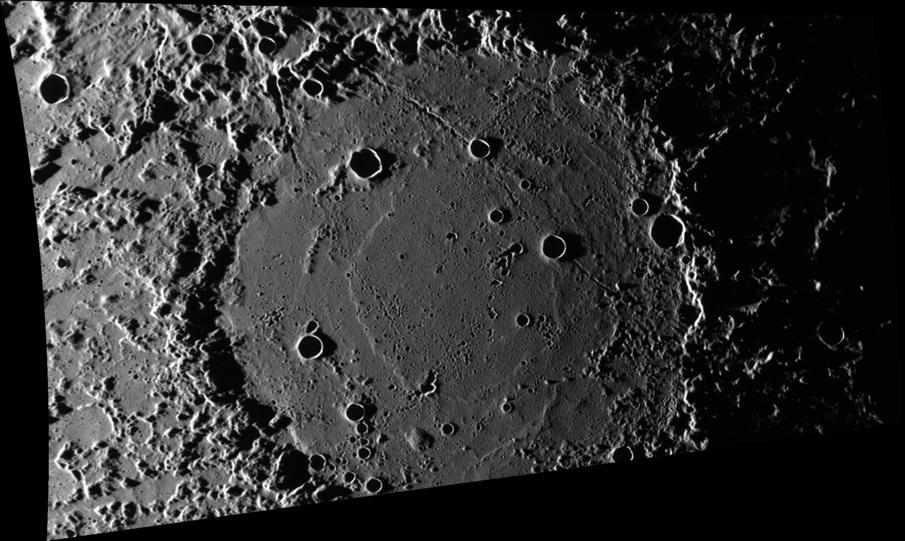
Image courtesy of
NASA/JPL
Is Mercury an active planet? Well, scientists have identified a few likely volcanoes, like the one shown below; but there aren't very many. It seems Mercury has much less tectonic activity than the Earth.

Image courtesy of
NASA/Johns Hopkins University Applied Physics Laboratory/Arizona State University/Carnegie Institution of Washington
and
Head et al., Science 321, 69 (2008)
Since it is so close to the Sun, the temperature of Mercury can rise to very high levels:
During the day, about 690 Kelvin (about 420 Celsius)
During the night, about 100 Kelvin (about -170 Celsius)
Q: Why does the temperature change so drastically?
Although Venus is the brightest of the planets in the sky, it has been one of the most difficult to study in detail. The problem is that it is covered in clouds. Thick, thick, thick clouds.
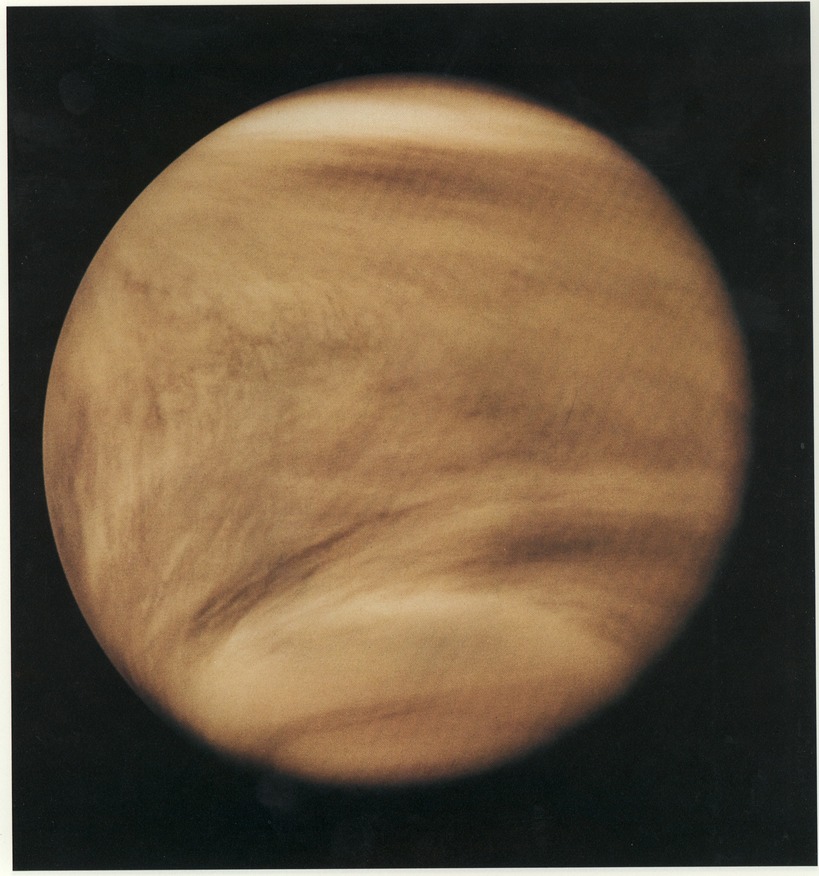
Pioneer Venus image of Venus in the ultraviolet
courtesy of
NASA and the NSSDCA
The clouds are so thick that we can't detect any features on the planet's solid surface. For many years, our space probes were stuck measuring properties of the Venereal (Venerian? Venusian?) atmosphere -- which turns out to be very different from that of the Earth.
Or is it?
The answer might depend on when you ask the question. The main constituent of Venus' atmosphere is carbon dioxide.
Q: What is the main consituent of Earth's atmosphere? Q: Does Earth's atmosphere contain carbon dioxide?
Earth's atmosphere is currently dominated by nitrogen and oxygen; carbon dioxide makes up less than one percent of the total.
But if one were to visit the Earth long ago, shortly after it formed, one would have found ... lots of carbon dioxide.
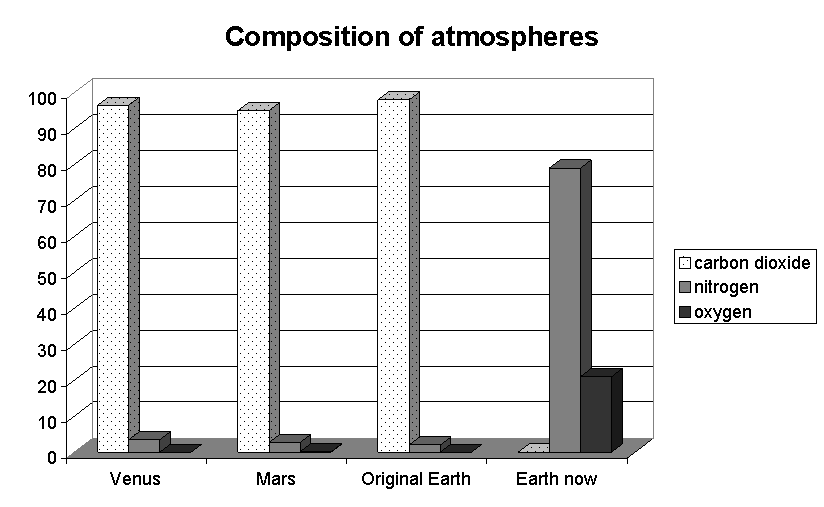
Graph courtesy of
Chris Evans, Dr. Roger Peters, Dr. Mike Thompson, Chris Gadsby, Ken Partridge, Roy Mylan, Yehoshua Sivan, Tom Nation, Dr. David Follows, Vikash Hemnath Seeboo
What changed? Well, on Venus, not much. But on the Earth, the great majority of the carbon dioxide was absorbed into the oceans covering most of the planet, Once in the water, the CO2 could easily react with minerals on the seafloor and become bound into the solid rock; and as sections of the seafloor were subducted into the Earth's interior due to techtonic motion, the carbon dioxide was buried deep underground.

Image courtesy of
USGS
Q: So, why might Venus still have a thick CO2 atmosphere?
Right. It might be connected to the lack of oceans, and the lack of large-scale tectonic plate activity.
This very thick atmosphere of carbon dioxide has some serious consequences for the planet.
Q: The orbit of Venus has a semi-major axis of 0.72 AU,
considerably smaller than that of the Earth.
What might we expect its surface temperature to be?
( You remember that formula, right?)
Fine.

Q: So we'd expect the temperature of Venus to be ....
... roughly 326 Kelvin, or about 53 Celsius. That's hot, for sure, but not hot enough to boil water, or ignite paper. Why, an ordinary person could survive for several hours in a room at that temperature.
But radio observations of Venus back in the 1960s -- some of them conducted as the Ph.D. research of some fellow named Carl Sagan -- suggested that the surface temperature of Venus was higher; much higher.
A series of Soviet spacecraft landed on Venus between 1967 and 1982. Conditions on the surface were ... difficult, so they were only able to record data and send it back to Earth for brief periods. But they did provide some views of the surface.

Mosaic from Venera 13 courtesy of
Don P. Mitchell

Mosaic from Venera 14 courtesy of
Don P. Mitchell
These probes measured directly the surface temperature, which was around 465 Celsius = 738 Kelvin.

What's going on? Why is Venus so much hotter than we expect?
The short answer is the greenhouse effect, but what does that mean? The key is that very thick atmosphere of carbon dioxide. It turns out that carbon dioxide molecules interact very differently to ordinary visible light and infrared light.
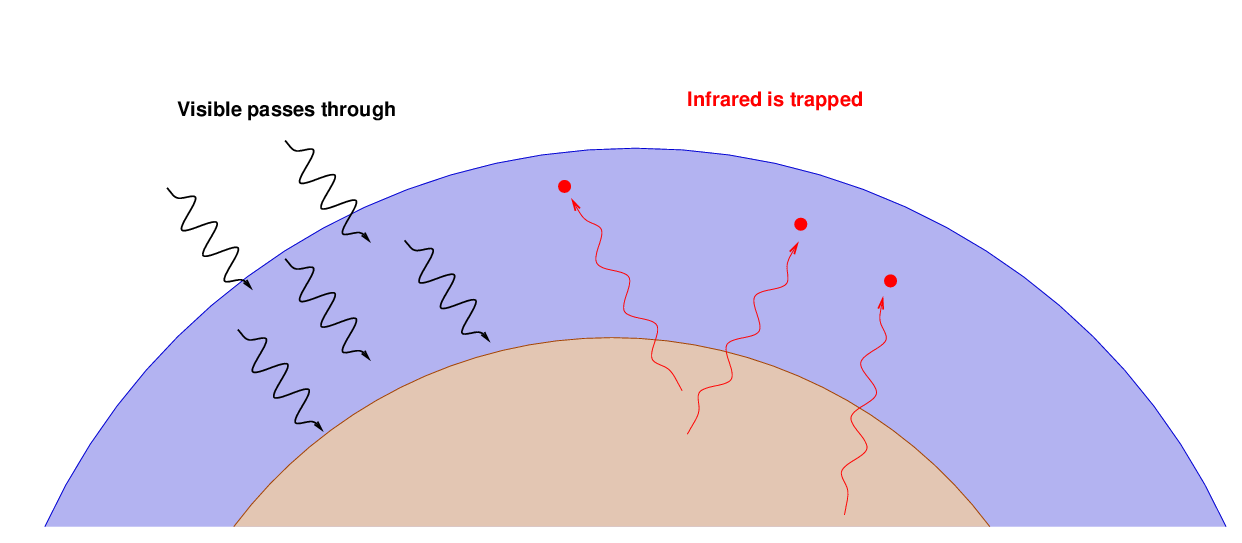
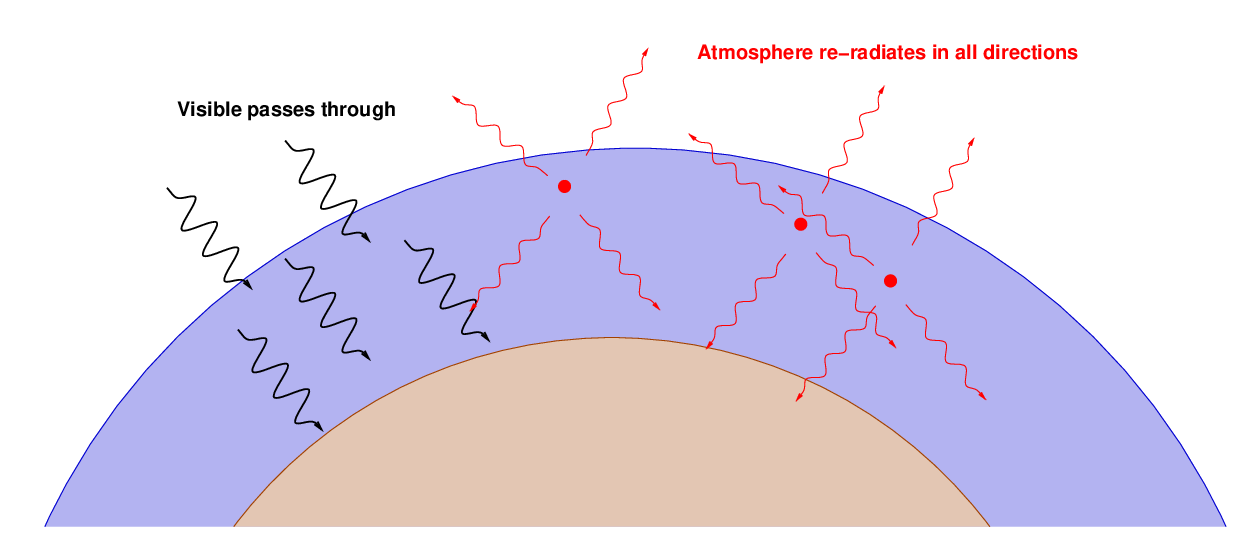
As a result, the temperature of the surface and the lower layers of the atmosphere rises; the temperature will continue to rise until the warmer ground and atmosphere produce so much infrared radiation that the small amount which leaks out into space balances the incoming visible light energy.
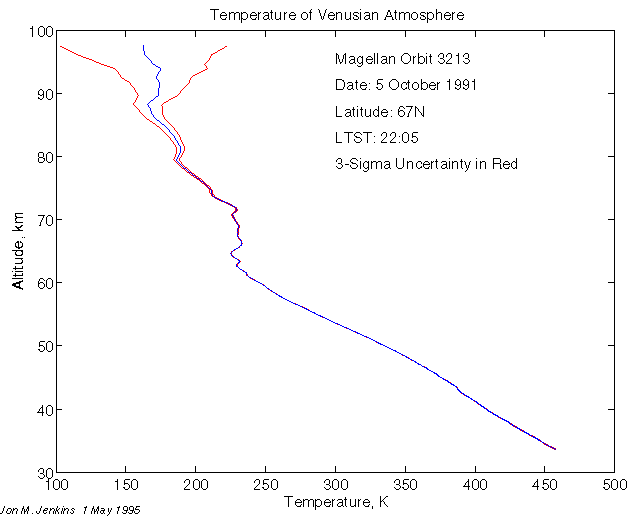
Graph courtesy of
Tom Jenkins of SETI Institute and
the Mars Global Surveyor Radio Science Team
By the way, does the Earth's atmosphere cause the EARTH to be warmer than expected, too? The simple answer is "yes". If we take a very, very simplified view of the situation (assuming, for example, that the Earth is a perfect blackbody which rotates instantaneously), then the "expected" temperature is clearly 279 K.

The "actual" average temperature of the Earth -- well, what does that even mean? The typical temperature at the equator is much warmer than that at the poles, and how do we "average" them together? This is a tricky subject, but some experts in the field have estimated that during the period 1951 - 1980, the overall average temperature of the Earth was around 14 Celsius.
Q: What is that average temperature of 14 Celsius converted
to the Kelvin scale?
Q: Does Earth also show evidence of the greenhouse effect?
Yes, indeed, the Earth is warmer than one would expect for an airless planet in its orbit. If one performs a more sophisticated calculation for the "expected" temperature, one which includes factors such as the albedo and thermal emissive properties of the surface, and the rotation of the planet, one finds the "expected" temperature is somewhat lower than 279 Kelvin; and thus the size of the greenhouse effect is somewhat larger, to bring the actual temperature up to about 287 Kelvin.
While determining the "average" temperature over an entire planet is a complex project, measuring the average temperature at a single location is not so difficult. Over the past 100 years, there is very strong evidence that the temperature of the Earth's surface and lower atmosphere has been rising -- and that rise has become quicker recently.
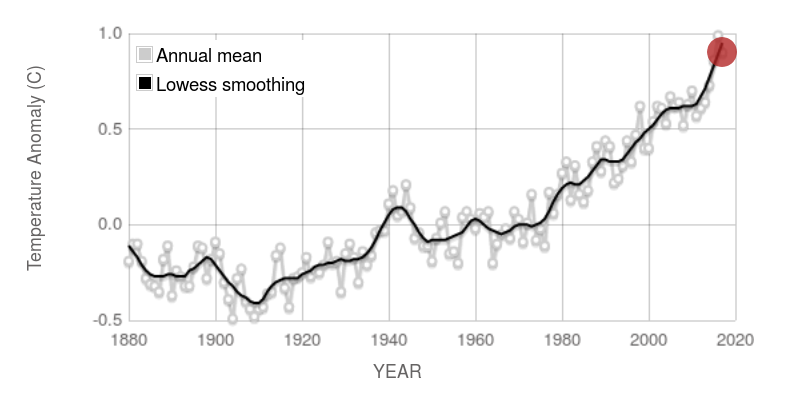
Graph courtesy of
NASA/GISS
Measurements from a number of sources show that something else is increasing rapidly in the recent past: the concentration of carbon dioxide in the Earth's atmosphere.
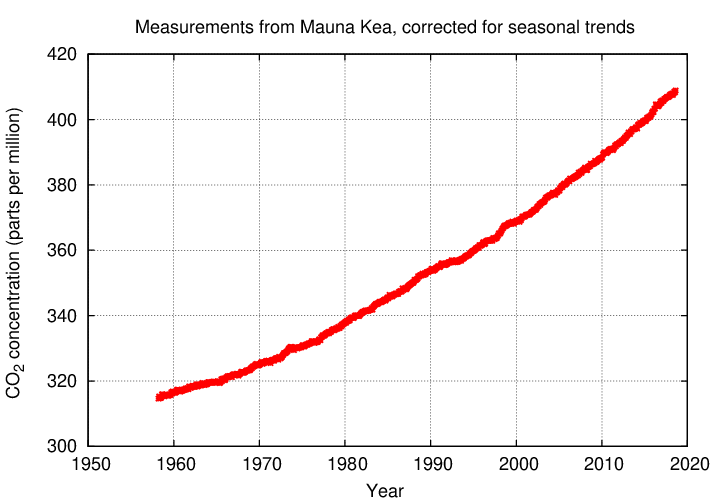
Data provided by
NOAA
What's so special about carbon dioxide? It's not the only molecule which can cause the greenhouse effect by trapping infrared radiation -- water vapor and methane are two other examples. But CO2 turns out to be very important for the Earth and Venus because
The figure below shows a model of the spectrum of infrared radiation emitted by one portion of the Earth on a warm day in 1970. On this day, the surface temperature was around 320 Kelvin = 47 Celsius = 117 Fahrenheit. That's very hot, but since the satellite was looking at a section of Africa near the equator, just after noon, it make sense.
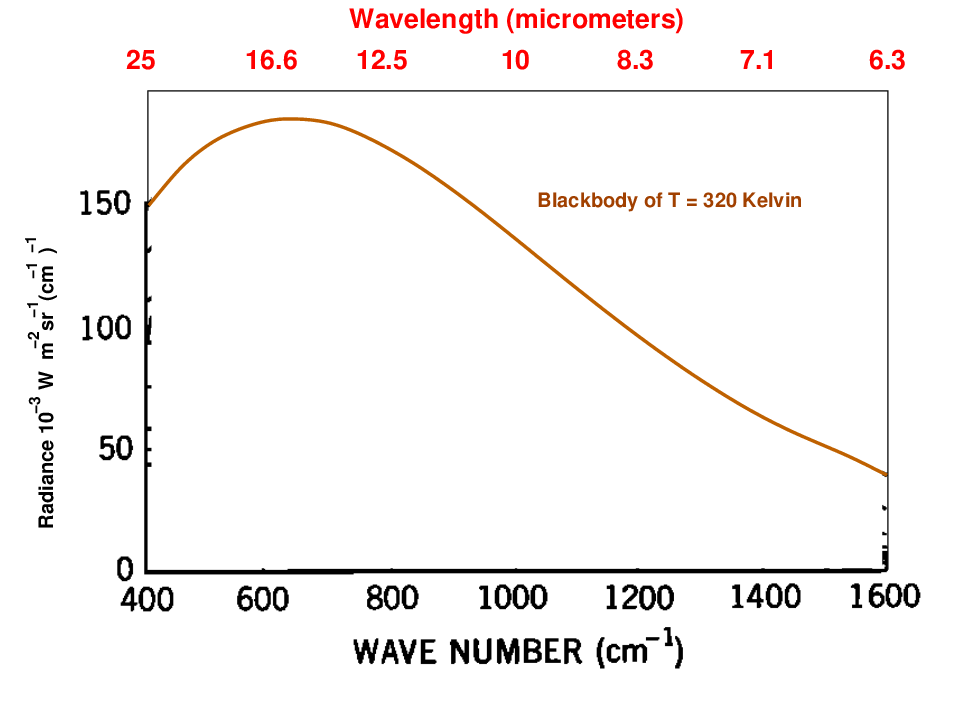
Graph based on
Hanel et al., Journal of Geophysical Research, 77, 2629 (1972)
and
The American Chemical Society
Q: At what wavelengths is most of this infrared radiation emitted?
Right. The peak of the spectrum occurs around 12 to 18 micrometers.
But that's a simple model, without an atmosphere. When we examine the REAL MEASUREMENTS, taken through the real atmosphere, we see something different:
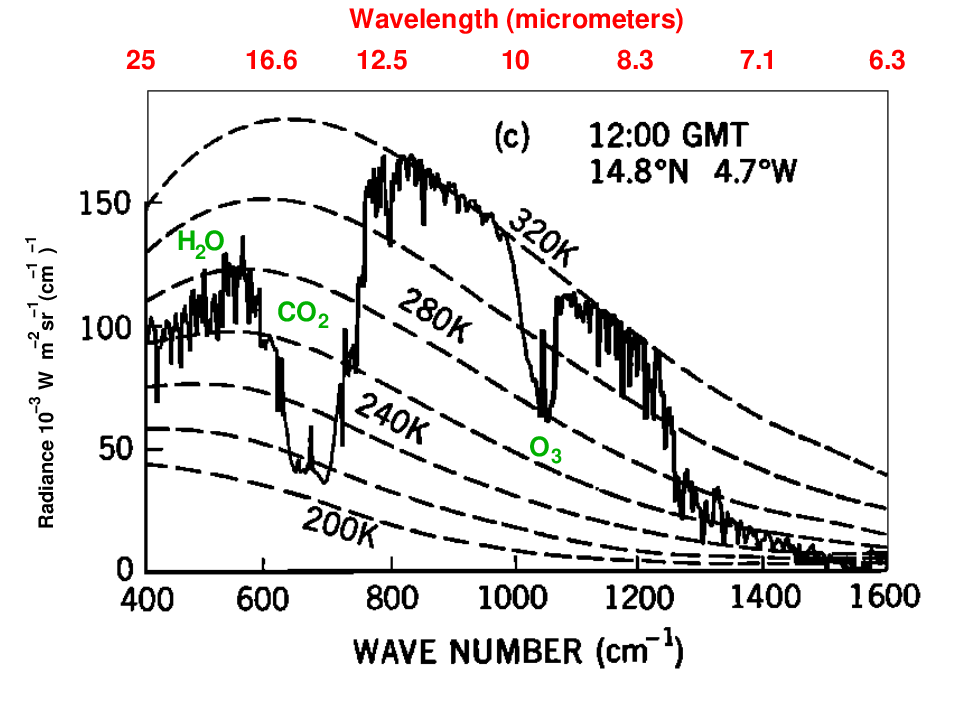
Graph based on
Hanel et al., Journal of Geophysical Research, 77, 2629 (1972)
and
The American Chemical Society
It's the CO2 which is responsible for blocking much of the infrared radiation from the surface.
Okay, enough about the atmosphere. Let's focus on the surface again.
The Pioneer Venus mission was able to provide our first look at the overall surface of Venus using a "simple" version of radar. It sent pulses of radio waves straight down to the surface, where some of them bounced off and back up to the spacecraft. By measuring the time it took for the radio waves to make the round trip, scientists could deduce the height of the spacecraft above the ground.
As Pioneer Venus orbited the planet, this "radio altimeter" allowed us to create a low-resolution map of the entire planet. Note that the smallest "pixels" are over 100 km in size, so it's a pretty rough picture.
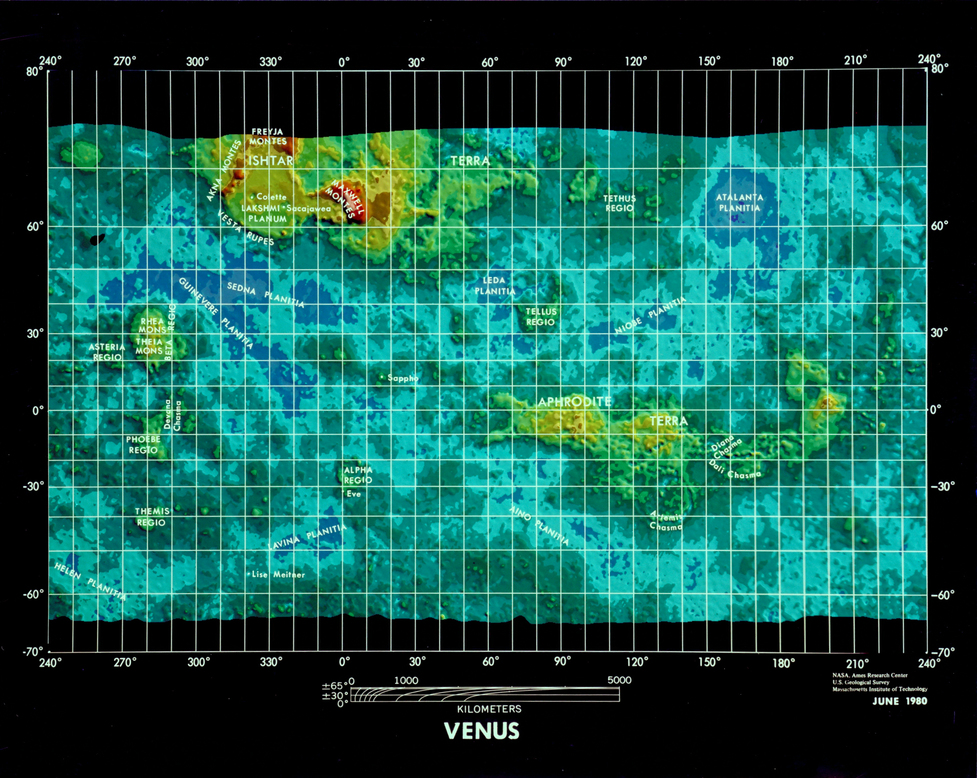
Image courtesy of
NASA Ames Reseach Center, U.S Geological Survey and Messachusetts Institute of Technology, and Wikimedia
We can see two large "continents", as well as a few much smaller ones, sitting amidst a generally lower, flatter terrain.
In 1990, a spacecraft equipped with a more powerful version of radar reached Venus. The Magellan mission featured "synthetic aperture radar" (SAR), which could discern much smaller features from orbit.
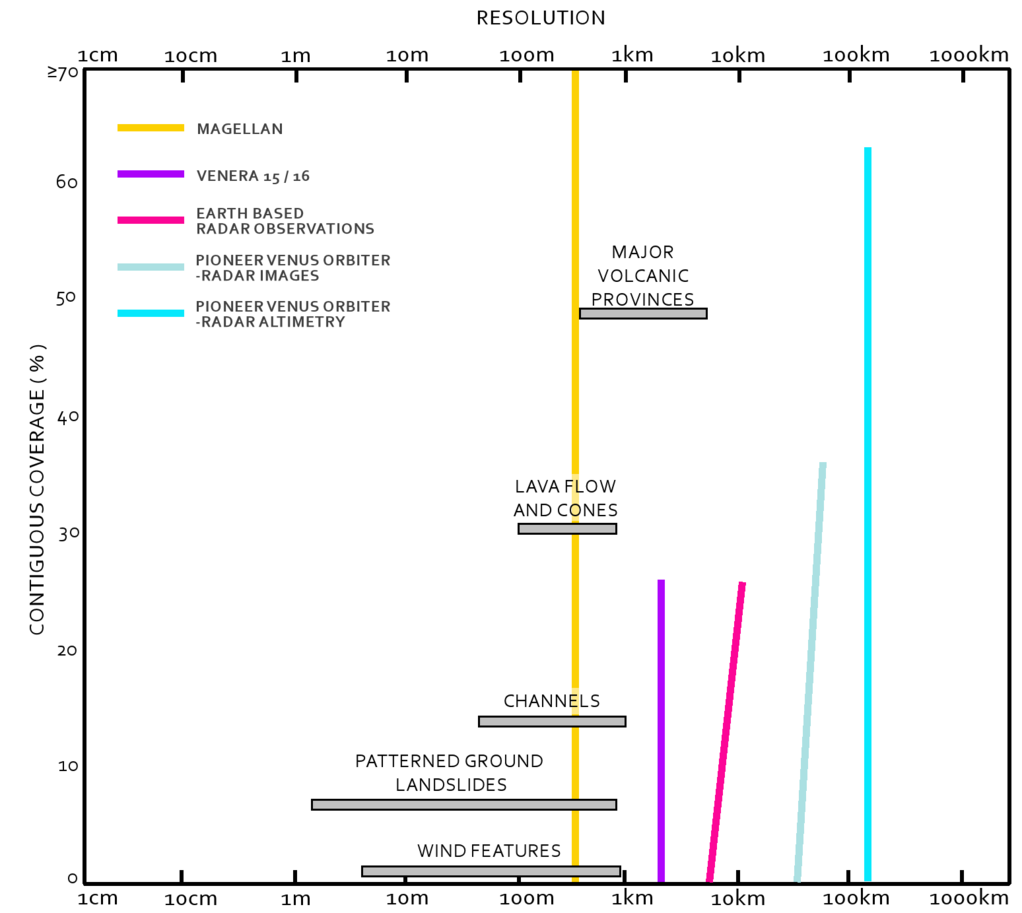
Image courtesy of
NASA/JPL
The maps that Magellan made allow us to study the surface of Venus in great detail.
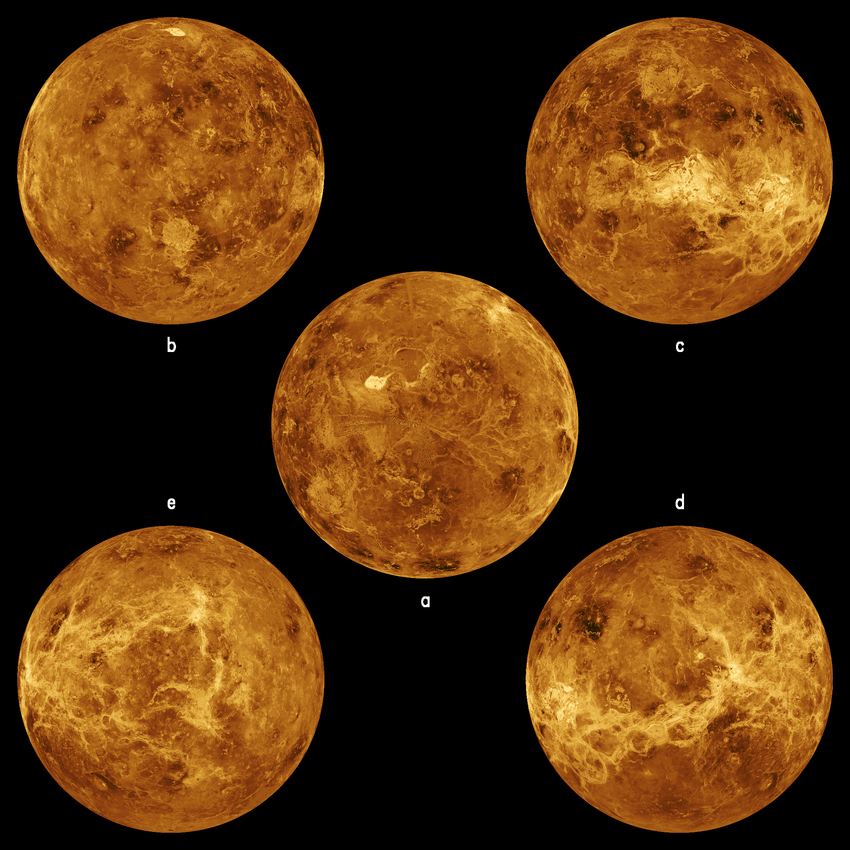
Images courtesy of
NASA/JPL
We might begin by reviewing the ideas behind using craters to determine the age of a planetary surface.
Let's put these ideas into practice on the surfaces of Mercury and Venus.
Now, for Mercury, this is straightforward: several spacecraft have flown past Mercury, providing images of its surface. Without any atmosphere, there is nothing to block our view of features. The image below shows the same region of the planet: in greyscale on the left, and with highly enhanced colors on the right to show regions of different chemical composition.
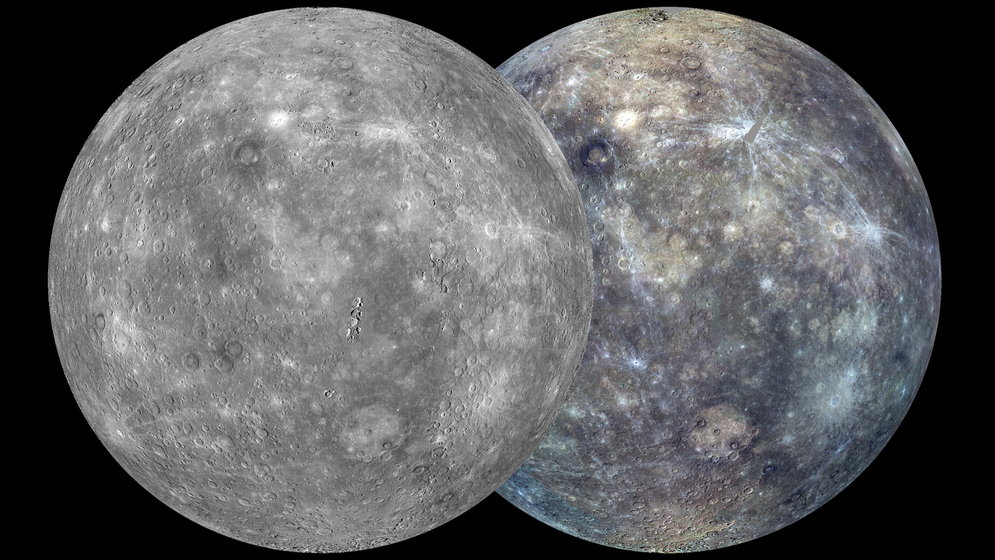
Image courtesy of
NASA/Johns Hopkins University Applied Physics Laboratory/Carnegie Institution of Washington
One can see a LOT of craters, large, small, and in between.
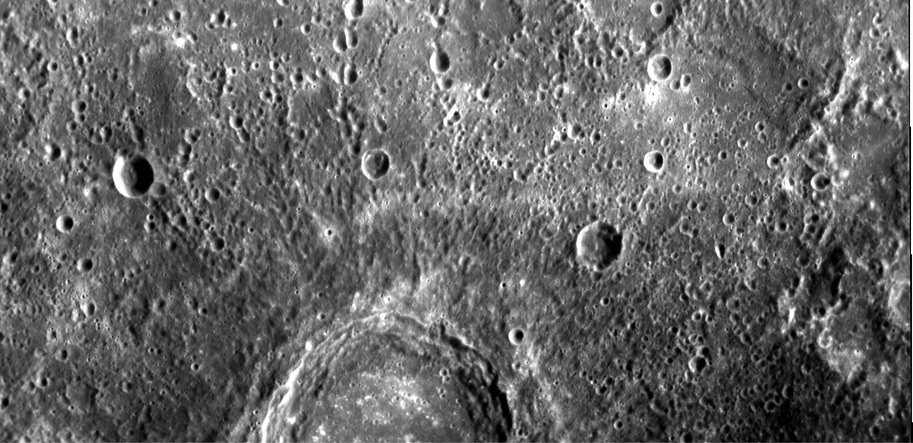
Image of Mercury courtesy of
NASA/Johns Hopkins University Applied Physics Laboratory/Carnegie Institution of Washington
Scientists very carefully examined the images, separating craters from other geological features. In the image below, for example, green circles denote craters, while yellow mark hills.
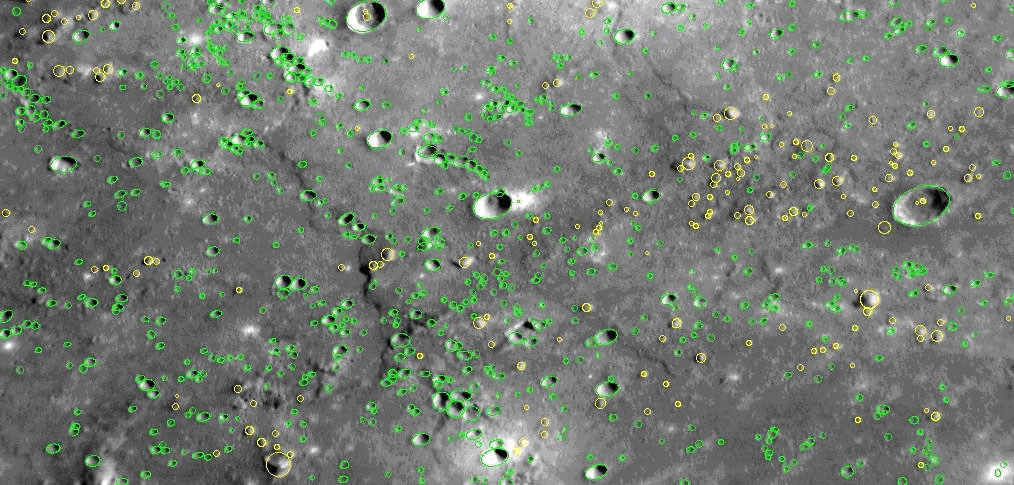
Image courtesy of
NASA/Johns Hopkins University Applied Physics Laboratory/Carnegie Institution of Washington
One team concentrated on a section of the surface which showed a particularly high number of craters; they interpret this as an indication that this region is considerably older than the less-cratered surroundings.
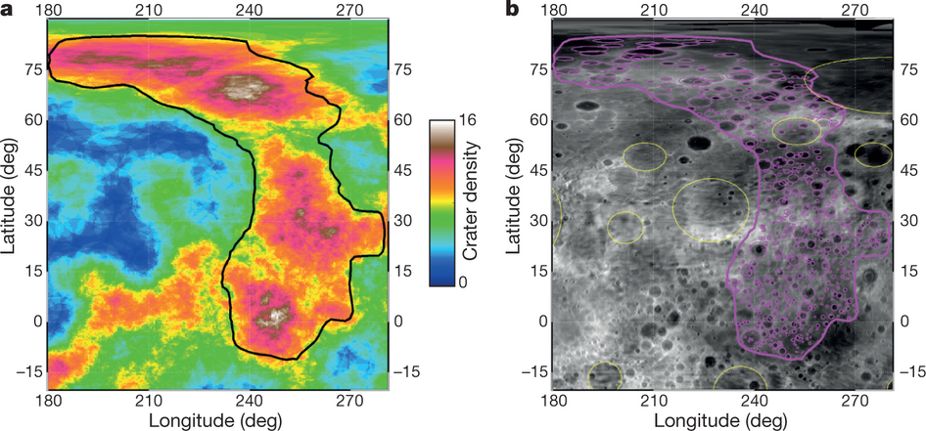
Figure 1 taken from
Marchi et al., Nature 499, 59 (2013)
When they examined the number of craters of different sizes, they found a relationship which fell between some of the oldest regions of the lunar surface (before the Nectaris basin impact), and newer portions of the lunar surface (after the Nectaris basic impact). The team concluded that this part of Mercury's surface has an age of roughly 4.0 - 4.1 billion years.
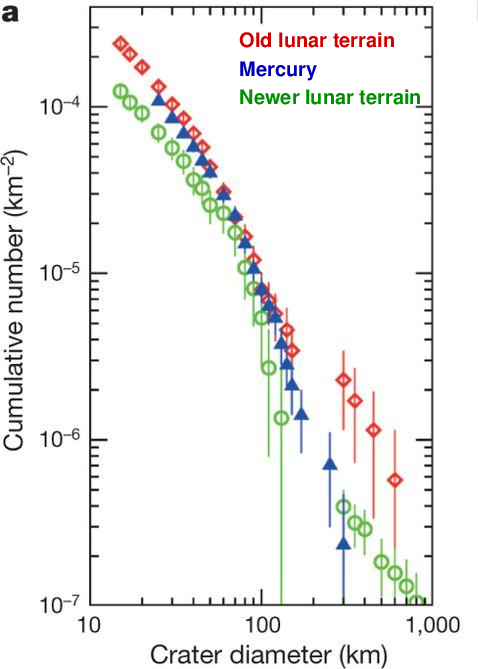
Figure 2a taken from
Marchi et al., Nature 499, 59 (2013)
with added labels
The surface of Venus is quite different. The images below show regions roughly 1000 x 1000 km in size. How many craters do you see?
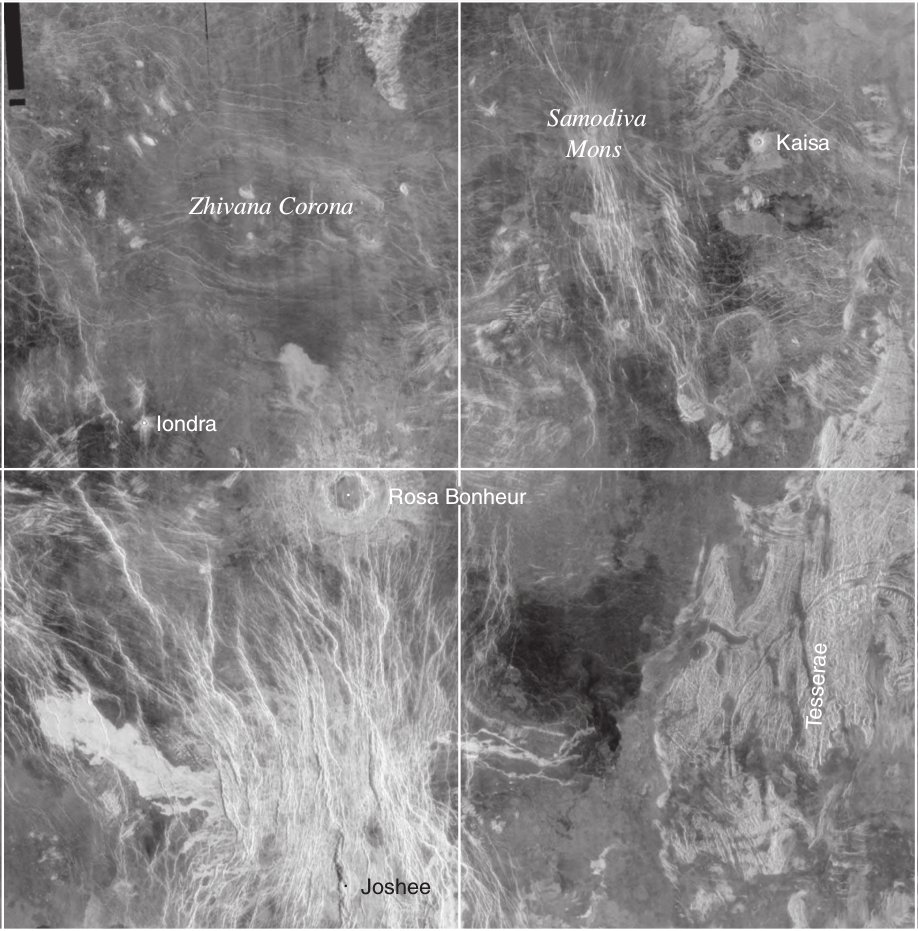
Image courtesy of
USGS Astrogeology Science Center
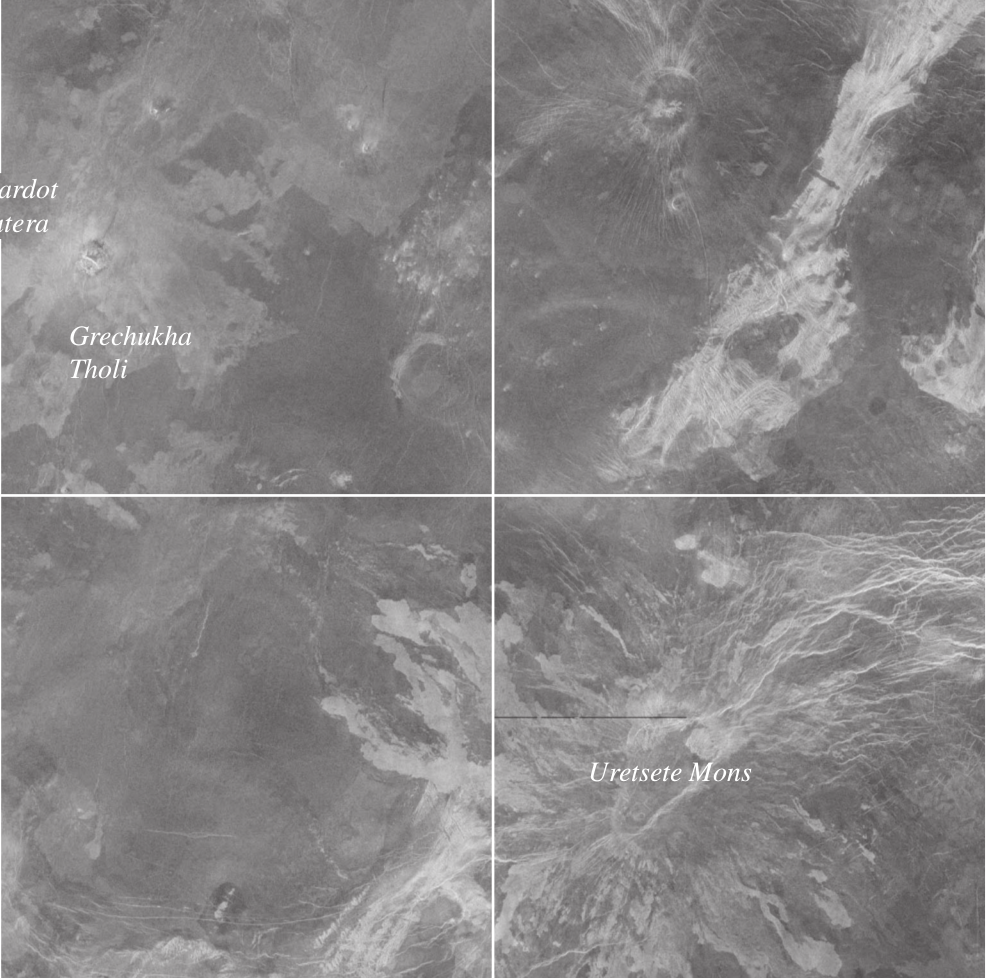
Image courtesy of
USGS Astrogeology Science Center
The answer: not many. We can see a few very large craters, but their outlines are faded rather than crisp and sharp.
Although there are a few crisp, relatively new impact craters on the surface, such as Isabella,
there are many more eroded remnants of craters, like Alcott:
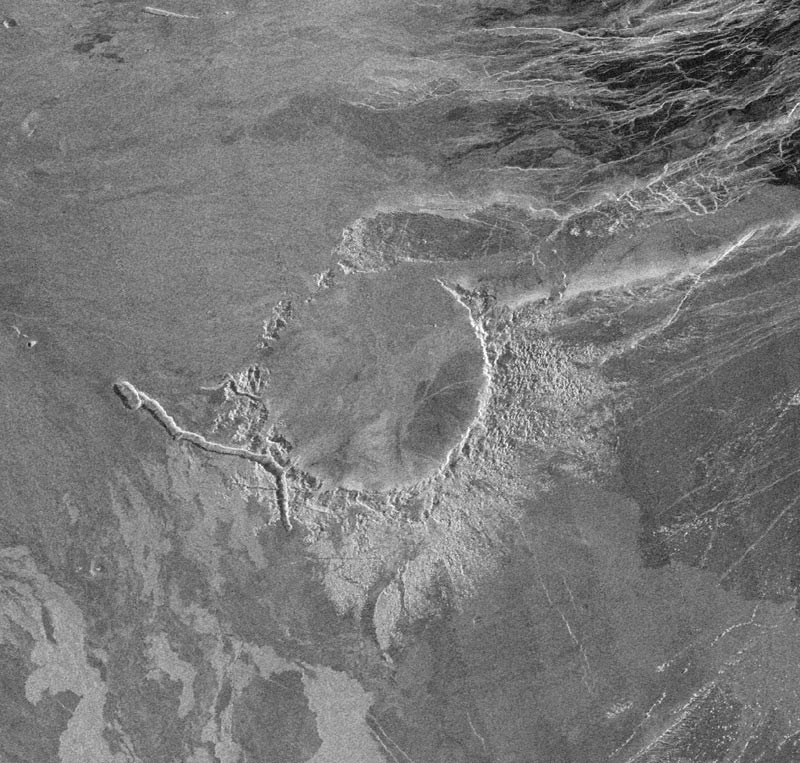
Image of Alcott courtesy of
Magellan team and Wikipedia.
Q: Why do we see so few craters on the surface of Venus?
There are several reasons, but the major ones are:
Venus has a lot of volcanoes.
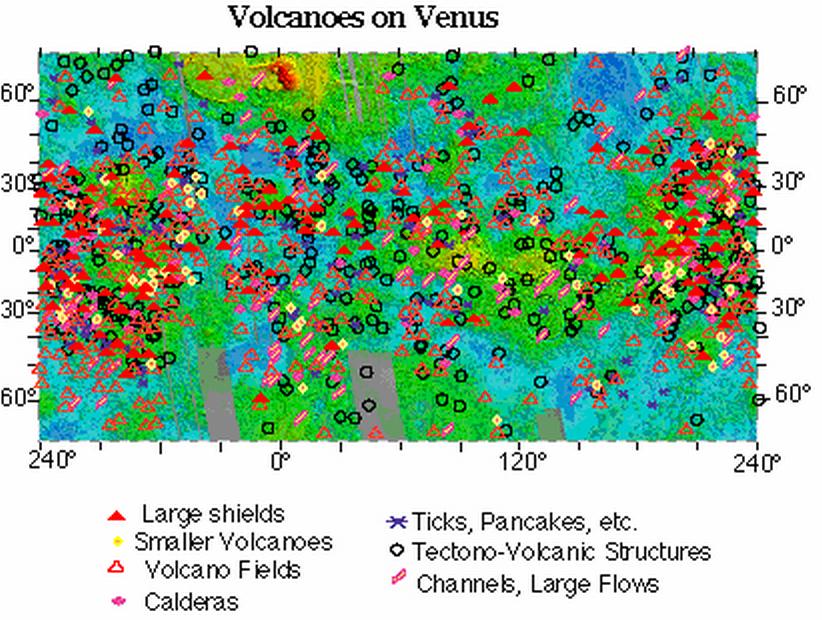
Map of volcanoes on Venus courtesy of
Planet Volcano at Oregon State University
We can see the remnants of lava flows as they spread out over the landscape, from overhead ...
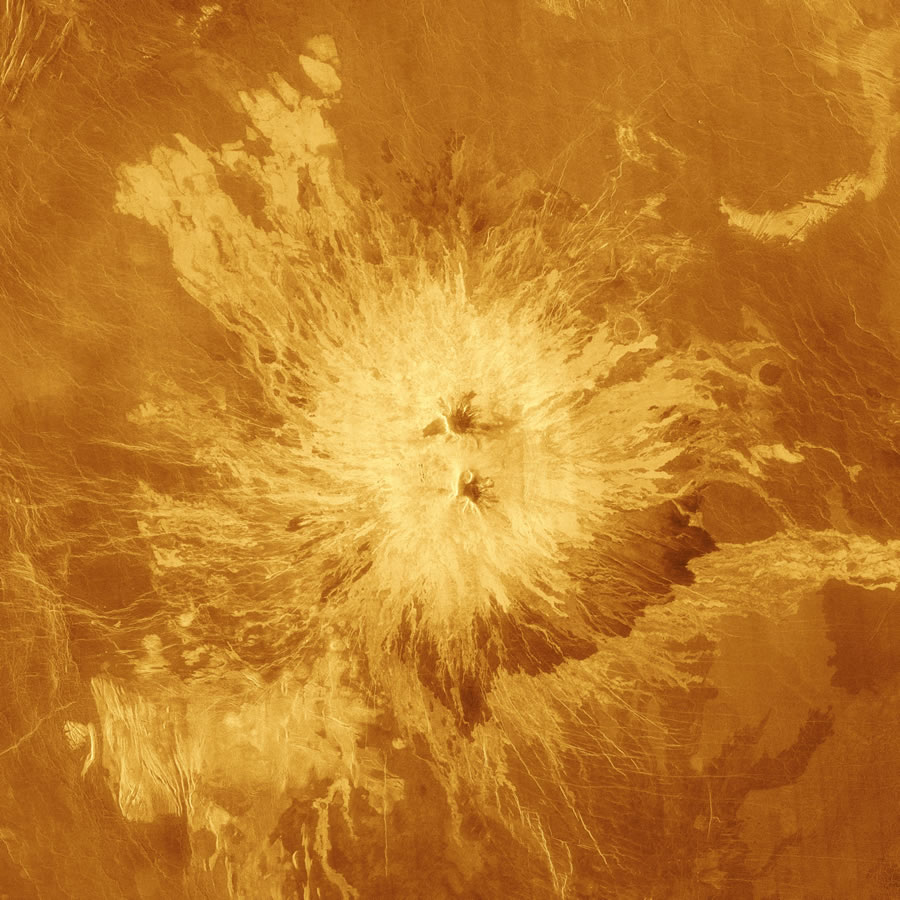
Image courtesy of
NASA/JPL
... or in a computer-generated "side view":
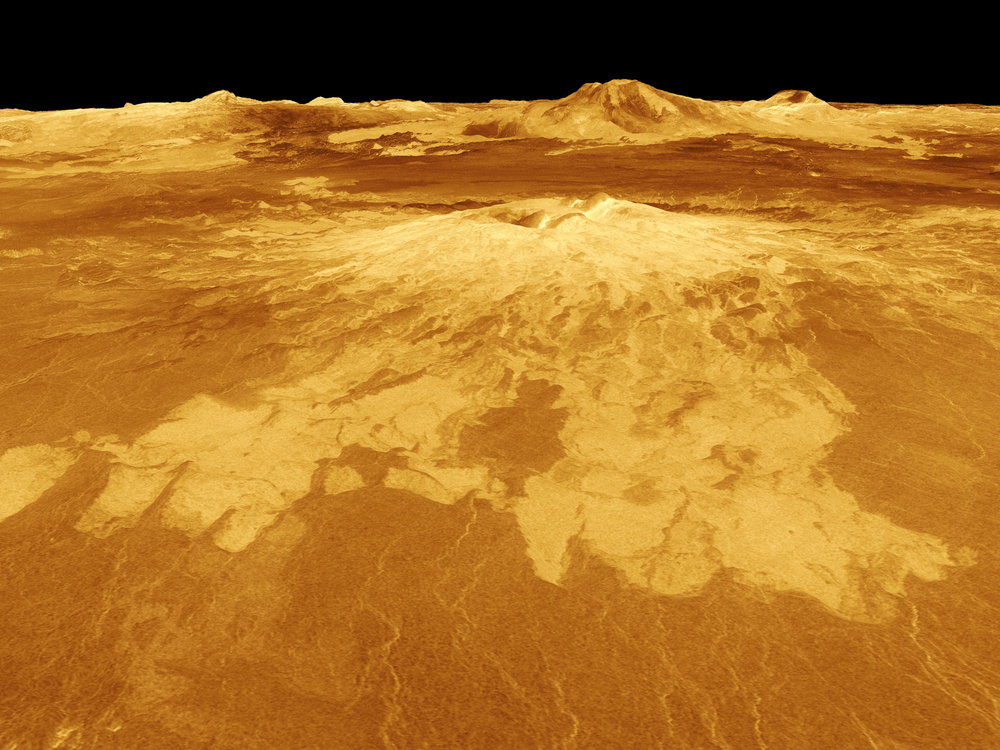
Image courtesy of
NASA/JPL
Some of the "pancake domes" formed by the material which flowed out of volcanoes on Venus are huge: many hundreds of kilometers across, far larger than any volcanoes on Earth. On Earth, the motion of tectonic plates carry the crust past "hot spots" in the mantle, preventing any one volcano from erupting for very long. On Venus, the lack of tectonic motion may allow a single volcano to erupt over and over and over, creating these giant "pancakes".
Based on the relatively few craters found on Venus, one can estimate the age of its surface to be perhaps 0.6 billion years old, much younger than that of Mercury. And it may be younger still; a pair of somewhat recent papers
argue that the typical age may be closer to 0.2 billion years old.
 Copyright © Michael Richmond.
This work is licensed under a Creative Commons License.
Copyright © Michael Richmond.
This work is licensed under a Creative Commons License.